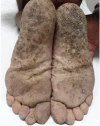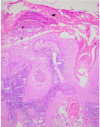Case Report of Cutaneous Squamous Cell Carcinoma at the Wrist Joint and the Public Health Crisis of Arsenicosis
- PMID: 33815911
- PMCID: PMC8009643
- DOI: 10.5696/2156-9614-11.29.210314
Case Report of Cutaneous Squamous Cell Carcinoma at the Wrist Joint and the Public Health Crisis of Arsenicosis
Abstract
Context: Arsenicosis is caused by long term (6 months plus) ingestion of arsenic above a safe dose, characterized by skin lesions and possible involvement of internal organs. Arsenicosis is common in India and Bangladesh where naturally occurring high concentrations of arsenic in the earth's crust contaminate ground water, causing adverse health effects.
Case presentation: We report a case of a 55-year-old Indian male, resident of a known arsenic endemic region of Uttar Pradesh who suffered from characteristic pulmonary and cutaneous features of chronic arsenic toxicity which included radiological findings of interstitial lung disease, hyperkeratotic lesions over the palms and soles, rain drop like pigmentation over the trunk, and carcinomatous changes at the wrist joint. The patient was started on chelating agents (d-penicillamine) and oral retinoids (isotretinoin) followed by the surgical excision of the carcinoma.
Discussion: Environmental contamination with arsenic is a well-known health hazard in South Asian countries. The main source is consumption of contaminated ground water for domestic purposes. Cutaneous lesions, internal organ involvement including interstitial lung disease and carcinomas as observed in our patient have been reported in the literature. Various mechanisms like epigenetic changes and arsenic-induced immune suppression have been proposed for the development of cutaneous carcinomas with prolonged exposure to arsenic.
Relevance to clinical practice: Among the various causes of palmo-plantar hyperkeratosis, arsenicosis should be kept in mind when presenting in combination with pigmentary changes and carcinomatous growth from an arsenic-endemic region.
Conclusions: People residing in arsenic-endemic regions should be made aware of arsenic-related health hazards. Rainwater harvesting and good nutrition are the simplest measures which could be adopted by the exposed population in affected areas. Several methods have also been employed by governmental and non-government organizations to separate arsenic from contaminated water to combat arsenic-related diseases and carcinomas.
Competing interests: The authors declare no competing financial interests.
Keywords: arsenicosis; palmo-plantar hyperkeratosis; squamous cell carcinoma.
© Pure Earth 2021.
Figures








Similar articles
-
Effect of Safe Water on Arsenicosis: A Follow-up Study.J Family Med Prim Care. 2014 Apr;3(2):124-8. doi: 10.4103/2249-4863.137626. J Family Med Prim Care. 2014. PMID: 25161968 Free PMC article.
-
Arsenic and non-malignant lung disease.J Environ Sci Health A Tox Hazard Subst Environ Eng. 2007 Oct;42(12):1859-67. doi: 10.1080/10934520701566926. J Environ Sci Health A Tox Hazard Subst Environ Eng. 2007. PMID: 17952787
-
Arsenic contamination in groundwater in Bangladesh: implications and challenges for healthcare policy.Risk Manag Healthc Policy. 2018 Nov 30;11:251-261. doi: 10.2147/RMHP.S153188. eCollection 2018. Risk Manag Healthc Policy. 2018. PMID: 30584381 Free PMC article. Review.
-
Epidemiology and prevention of chronic arsenicosis: an Indian perspective.Indian J Dermatol Venereol Leprol. 2008 Nov-Dec;74(6):582-93. doi: 10.4103/0378-6323.45099. Indian J Dermatol Venereol Leprol. 2008. PMID: 19171980 Review.
-
Diagnosis of arsenicosis.J Environ Sci Health A Tox Hazard Subst Environ Eng. 2003 Jan;38(1):255-72. doi: 10.1081/ese-120016893. J Environ Sci Health A Tox Hazard Subst Environ Eng. 2003. PMID: 12635831 Review.
References
-
- Chakraborti D, Rahman MM, Das B, Chatterjee A, Das D, Nayak B, Pal A, Kumar U, Chowdhury , Ahmed S, Kumar B, Biswas , Sengupta MK, Hossain MA, Samanta G, Roy MM, Dutta RN, Saha KC, Mukherjee SC, Pati S, Kar PB, Mukherjee A, Kumar M. Groundwater arsenic contamination and its health effects in India. Hydrogeol J. 2017;(25):1165–1181. doi: 10.1007/s10040-017-1556-6. - DOI
-
- Shrivastava A, Ghosh D, Dash A, Bose S. Arsenic Contamination in Soil and Sediment in India: Sources, Effects, and Remediation. Curr Pollution Rep. 2015;(1):35–46. doi: 10.1007/s40726-015-0004-2. - DOI
Publication types
LinkOut - more resources
Full Text Sources
Other Literature Sources

